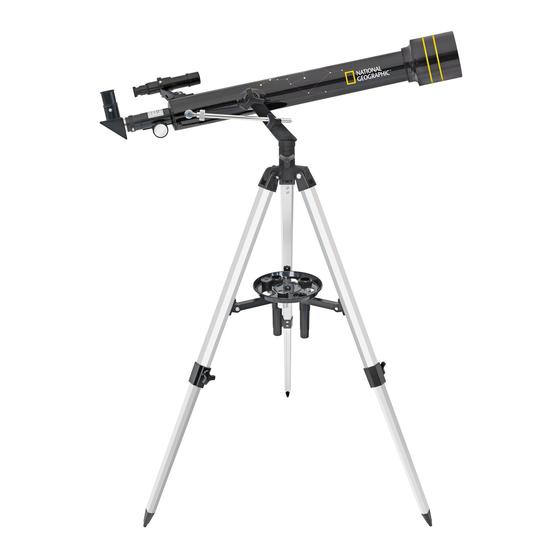Advertisement
Quick Links
Advertisement

Subscribe to Our Youtube Channel
Summary of Contents for National Geographic NG60AZ
- Page 1 NG60AZ Telescope Instructions Owner’s Manual...
- Page 2 P. Optical tube assembly Q. Dew shield R. Tripod leg (3) WARNING! NEVER aim your telescope at the sun or even close to the sun! Instant and irreversible damage can occur, including blindness! Do not let children use any telescope without adult supervision.
- Page 3 As a terrestrial (land) telescope, the NG60AZ delivers great views of mountains, valleys, and many other features of the world around us. You can also use the NG60AZ to study animals and landscapes at a distance. To obtain the best performance from your telescope, please read this manual carefully and completely.
- Page 4 Keep your box for storage or in case you ever need to ship your telescope. 2) Extend the legs, and lock each one at the desired height with the supplied tripod adjustment knob (See Fig.
- Page 5 the holes at the end of the arm line up with the hole through the attachment point on the tripod leg (See Fig. 4). Insert the bolt to attach the tripod support bracket to the tripod leg and tighten the nut. Repeat this procedure with the other two legs. (Fig.
- Page 6 (See Fig. 9). Position the finder scope bracket onto the telescope tube so that the holes in the base of the bracket line up with the exposed holes in the telescope tube. Replace the two knurled thumbscrews and tighten securely (See Fig.
- Page 7 (Fig. 9) 9) Insert the diagonal mirror into the focusing tube (See Fig. 11). Secure by tighten- ing the small chrome set screw located on the focusing tube (See Fig. 12). (Fig. 11) 10) Insert the 25-mm eyepiece into the diagonal mirror (See Fig. 13). Tighten the small chrome set screw to hold the eyepiece securely in place (See Fig.
-
Page 8: Finder Scope Alignment
3X Barlow lens between the eyepiece and the focusing tube (See Fig. 15). FINDER SCOPE ALIGNMENT Since a telescope has a narrow field of view by design, it can be challenging to locate a particular star or planet. For this reason the telescope is fitted with a low-power, wide- field miniature telescope called a finder scope. -
Page 9: About Magnification
To calculate the power of your telescope with any particular eyepiece, simply divide the focal length of the telescope (700 mm) by the focal length of the eyepiece (indicated in “mm” on the eyepiece collar). -
Page 10: Using Your Telescope For Terrestrial Viewing
Then loosen the tilt and pan arm by turning it counterclockwise. You can then hold the tilt and pan arm and aim the telescope in the desired direction. Then tighten the tripod locking knob and the tilt and pan arm. - Page 11 If, after several attempts, you cannot remove the particles, take the telescope to an optical professional for cleaning. If you keep the dust caps on your telescope when it is not in use and avoid handling the lenses or mirrors, only minimal optical maintenance of your telescope should be required.
- Page 12 The planet and its rings appear pale yellow. The major division in the rings, the Cassini division, is possible to see if you keep the telescope firmly in position. Uranus and Neptune are the last of the solar system’s gas giants. They do not provide as spectacular a sight as Jupiter or Saturn, but are nonetheless rewarding to see.
-
Page 13: Frequently Asked Questions
— providing significantly more detail and unveiling more stars, nebulae, and celestial objects. With the aid of a telescope, you will be able to enjoy exciting views of Saturn’s rings, Jupiter’s major moons, the Orion Nebula, and much more.













Need help?
Do you have a question about the NG60AZ and is the answer not in the manual?
Questions and answers